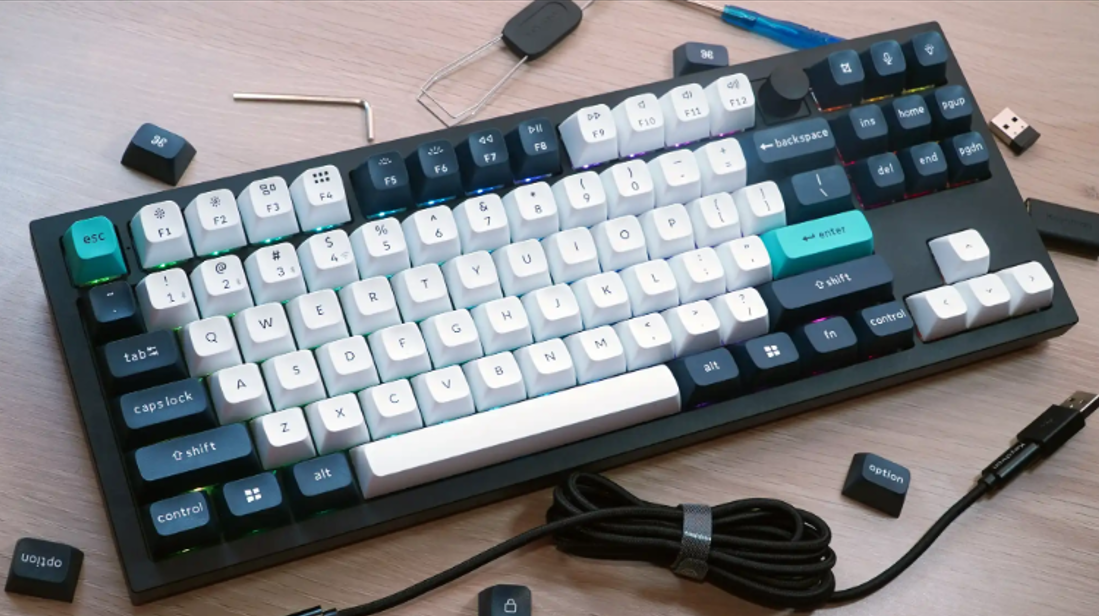Cleanliness is key to preserving the performance and longevity of your mechanical keyboard. Mechanical keyboards are awesome for typing and gaming. They make typing feel like a dream with their satisfying click-clack sounds. But just like any other device, they can get dirty with use. Dust, crumbs, and other gunk can build up between the keys, affecting performance and making your keyboard look yucky.
But don't worry! Cleaning your mechanical keyboard is easier than you might think. With just a few simple steps, you can have your keyboard looking and feeling as good as new. So, let's dive into a step-by-step guide to cleaning your mechanical keyboard.
Step 1: Gather Your Supplies
Before you start cleaning, it's essential to gather all the necessary supplies. Here's what you'll need:
1. Keycap Puller
This handy tool will help you remove the keycaps without damaging them.
2. Soft Brush
A soft-bristled brush, like a toothbrush or a dedicated keyboard brush, will help remove debris from the switches.
3. Compressed Air
This will help blast away any dust and crumbs hiding between the keys.
4. Isopropyl Alcohol
Use this for cleaning both the keycaps and the keyboard's surface.
5. Microfiber Cloth
For wiping surfaces and drying keycaps.
6. Container
A bowl or a sink filled with warm, soapy water for soaking the keycaps.
7. Cotton Swabs
Perfect for getting into small spaces.

Step 2: Remove the Keycaps
To remove the keycaps from your mechanical keyboard, it's best to start with the space bar. This key is typically larger and could be linked to a metal stabilizer bar, ensuring consistent key press distribution.
Now, you need a tool called a keycap puller. It helps you take the keycaps off without breaking them. Having a keycap puller makes the removal of even the space bar with a stabilizer quite simple. Gently put the keycap puller on top of a keycap. Make sure it's centered properly. Then, press down and pull up slowly. The keycap should come off easily.

In case you're utilizing a screwdriver, softly glide it beneath the space bar. Push it along while lifting the bar. The keycap should come off with a soft pop. You might need to lift the space bar a bit and then pull it to the side to get it off the hooks.
Other keys like Enter, Shift, Backspace, 0/Ins, and the big '+' might also come off the same way as the space bar in some keyboards.
But for the other regular keys, you can use the keycap remover or a screwdriver to lift them from underneath. Some keys might be easier to remove than others. Put all the keys in a container to soak and wash them.
For keys near the edge of the keyboard, like the arrow keys, you can use tweezers or a thin tool to remove them. This makes it easier to avoid damaging the keys or the keyboard itself. Take care to be gentle, to prevent any breakage.
Step 3: Clean the Keycaps
Now it's time to give your keycaps a good cleaning. Once the keycaps are off, you'll need a glass of warm, soapy water. Put the keycaps in the water and leave them to soak for a little while to loosen up any dirt or grime.

After they've soaked, take a soft brush or cloth and carefully scrub every single keycap to get rid of any remaining dirt. Be sure to clean both the top and bottom of the keycaps. When you're done scrubbing, rinse the keycaps under clean water to wash away the soap. Then, let them air dry completely before putting them back on your keyboard.
Step 4: Clean the Keyboard Body
This step helps remove any dirt or crumbs that might be hiding between the keys and around the edges. You'll need a cylinder of compressed air or an air blower for this job. These handy tools blow air to get rid of dust and dirt. Hold your keyboard upside down over a trash can or outside.

Then, using the air canister or blower, gently spray air between the keys and around the edges. This will blow out any yucky stuff that's hiding there. Remember to tilt the keyboard to different angles while blowing the air. This helps the dust and crumbs to fall out instead of getting stuck inside.
Step 5: Clean the Key Switches
Take a cotton swab, you know, those soft sticks with fluff on the end. Dip it in something called isopropyl alcohol. That's just a fancy name for a kind of liquid that helps clean stuff without causing harm.
First, make sure the cotton swab isn't too wet. A small amount of alcohol is sufficient. Prevent any liquid from dripping onto your keyboard!

Next, gently swipe the cotton swab around the switches. Be careful not to press too hard or use too much alcohol, as it could cause problems.
Once you've cleaned all the switches, give them a little time to dry before you put the keycaps back on.
And that's it! Your switches should be nice and clean, ready for you to type away without any problems.
Step 6: Dry and Reassemble Your Keyboard
Now that you've cleaned all the parts of your keyboard, it's time to put everything back together. First, make sure all the keycaps are fully dry.
Next, carefully reattach each keycap to the switch it matches. Make sure they're all lined up correctly and press down firmly to make sure they're securely attached.

Once each keycap is back on, give your keyboard a final once-over to make sure everything looks good. Check that there aren't any loose or crooked keycaps.
Now, plug your keyboard back into your computer and turn it on. Test out each key to make sure they're all working properly. If you notice any issues, double-check that the keycaps are all on correctly, and try pressing them down again to make sure they're secure.
Congratulations, you've successfully cleaned and reassembled your mechanical keyboard! With regular maintenance, your keyboard will continue to provide you with a comfortable typing experience for a long time.
Step 8: Maintenance Tips
To keep your mechanical keyboard clean and functioning well, it's a good idea to perform regular maintenance. This includes:
1. Regular Wiping
Use a soft cloth to wipe down your keyboard regularly. This helps remove dust and keeps it looking clean.
2. Keycap Cleaning
Every few months, use the keycap puller to remove keycaps and clean them separately. This helps prevent dirt buildup and keeps your keys working smoothly.
3. No Eating or Drinking
Avoid eating or drinking near your keyboard. Spills and crumbs can get inside and cause damage or make keys sticky.
4. Keyboard Cover
When you're not using your keyboard, consider covering it up. This helps protect it from dust and other debris.
By following these maintenance tips, you can keep your mechanical keyboard in great condition for a long time. Taking care of your keyboard will ensure that it continues to provide you with a comfortable typing experience whenever you need it.
Conclusion:
Cleaning your mechanical keyboard doesn't have to be a daunting task. With the right tools and a little bit of patience, you can keep your keyboard looking and feeling like new for years to come. By following the step-by-step guide outlined above and performing regular maintenance, you can ensure that your mechanical keyboard stays in top condition and provides you with a comfortable typing experience every time.
Discover the ultimate typing experience with Keychron, offering the best quality mechanical keyboards compatible with Mac, Windows, iPhone, and Android. Explore the premium Keychron K6, Keychron K8, Keychron K4, and Keychron V6 models, crafted for precision and style. Elevate your productivity and gaming with Keychron's superior craftsmanship and versatile designs.

